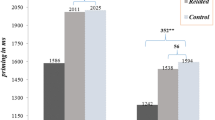Abstract
To examine the role of morphology in verbal working memory. Forty nine children, all native speakers of Arabic from the same region and of the same dialect, performed a Listening Word Span Task, whereby they had to recall Arabic uninflected words (i.e., base words), inflected words with regular (possessive) morphology, or inflected words with irregular (broken plural) morphology. Each of these words was at the end of a sentence (henceforth, target word). The participant’s task was to listen to a series of sentences and then recall the target words. Recall of inflected words was significantly poorer than uninflected words, and recall of words with regular morphology was significantly poorer than recall of words with irregular morphology. These findings, albeit preliminary, suggest a role of morphology in verbal working memory. They also suggest that, at least in Arabic, regular morphological forms are decomposed into their component elements and hence impose an extra load on the central executive and episodic buffer components of working memory. Furthermore, in concert with findings from other studies, they suggest that the effect of morphology on working memory is probably language-specific. The clinical implications of the present findings are addressed.
Similar content being viewed by others
References
Baayen R., Dijkstra T., Schreuder R. (1997) Singulars and plurals in Dutch: Evidence for a parallel dual-route model. Journal of Memory and Language 37: 94–117
Baddeley A. D. (1966) Short-term memory for word sequences as a function of acoustic, semantic, and formal similarity. Quarterly Journal of Experimental Psychology 18: 362–365
Baddeley A. D. (2002) Is working memory still working?. European Psychologist 7: 85–97
Baddeley A. D. (2003) Working memory and language: An overview. Journal of Communication Disorders 36: 189–208
Baddeley A. D., Thomson N., Buchanan M. (1975) Word length and the structure of short-term memory. Journal of Verbal Learning and Verbal Behavior 14: 575–589
Berent I., Pinker S., Shimron J. (2002) The nature of regularity and irregularity: Evidence from Hebrew nominal inflection. Journal of Psycholinguist Research 31: 459–502
Clahsen H. (1999) Lexical entries and rules of language: A multidisciplinary study of German inflection. Behavioral and Brain Sciences 22: 991–1013
Frost R., Deutsch A., Forster K. I. (2000) Decomposing morphologically complex words in a nonlinear morphology. Journal of Experimental Psychology: Learning, Memory, and Cognition 26: 751–765
Frost R., Forster K. I., Deutsch A. (1997) What can we learn from the morphology of Hebrew: A masked priming investigation of morphological representation. Journal of Experimental Psychology: Learning, Memory and Cognition 23: 829–856
Holes C. (1995) Modern Arabic: Structures, functions, and varieties. Longman, London
Hulme C., Maughan S., Brown G. D. (1991) Memory for familiar and unfamiliar words: Evidence for a long-term memory contribution to short-term memory span. Journal of Memory and Language 30: 685–701
Hulme C., Roodenrys S., Schweickert R., Brown G. D. A., Martin S., Stuart G. (1997) Word frequency effects on short-term memory tasks: Evidence for a redintegration process in immediate serial recall. Journal of Experimental Psychology: Learning, Memory, and Cognition 23: 1217–1232
Janssen N., Bi Y., Caramazza A. (2008) Tale of two frequencies: Determining the speed of lexical access for Mandarin Chinese and English compounds. Language and Cognitive Processes 23: 1191–1223
Just M. A., Carpenter P. A. (1992) A capacity theory of comprehension: Individual differences in working memory. Psychological Review 98: 122–149
MacDonald M. C., Christiansen M. H. (2002) Reassessing working memory: Comment on Just and Carpenter (1992) and Waters and Caplan (1996). Psychological Review 109: 35–54
Marton K., Schwartz R. G., Farkas L., Katsnelson V. (2006) Effect of sentence length and complexity on working memory performance in Hungarian children with specific language impairment (SLI): A cross-linguistic comparison. International Journal of Language Communication Disorder 41: 653–673
McCarthy J., Prince A. (1990) Foot and word in prosodic morphology: The Arabic broken plural. Natural Language and Linguistic Theory 8: 209–283
Munte T. F., Say T., Clahsen H., Schiltz K., Kutas M. (1999) Decomposition of morphologically complex words in English: Evidence from event-related brain potentials. Cognitive Brain Research 7: 241–253
Pinker S. (1999) Words and rules: The ingredients of language. Basic Books, New York
Ravid D., Farah R. (1999) Learning about noun plurals in early Palestinian Arabic. First Language 19: 187–206
Service E., Tujulin A. (2002) Recall of morphologically complex forms is affected by memory task but not dyslexia. Brain and Language 81: 42–54
Taft M. (1979) Recognition of affixed words and the word frequency effect. Memory & Cognition 7: 263–272
Taft M. (1988) A morphological decomposition model of lexical representation. Linguistics 26: 657–667
Taft M. (1994) Interactive activation as a framework for understanding morphological processing. Language and Cognitive Processes 9: 271–294
Walker I., Hulme C. (1999) Concrete words are easier to recall than abstract words: Evidence for a semantic contribution to short-term serial recall. Journal of Experimental psychology: Learning Memory, and Cognition 25: 1256–1271
Waters G. S., Caplan D. (1996) The capacity theory of sentence comprehension: Critique of Just and Carpenter (1992). Psychological Review 103: 761–772
Wright W. (1971) A grammar of the Arabic language. Cambridge University Press, Cambridge
Author information
Authors and Affiliations
Corresponding author
Rights and permissions
About this article
Cite this article
Cohen-Mimran, R., Adwan-Mansour, J. & Sapir, S. The Effect of Morphological Complexity on Verbal Working Memory: Results from Arabic Speaking Children. J Psycholinguist Res 42, 239–253 (2013). https://doi.org/10.1007/s10936-012-9200-z
Published:
Issue Date:
DOI: https://doi.org/10.1007/s10936-012-9200-z



